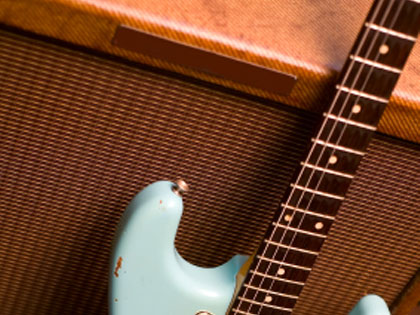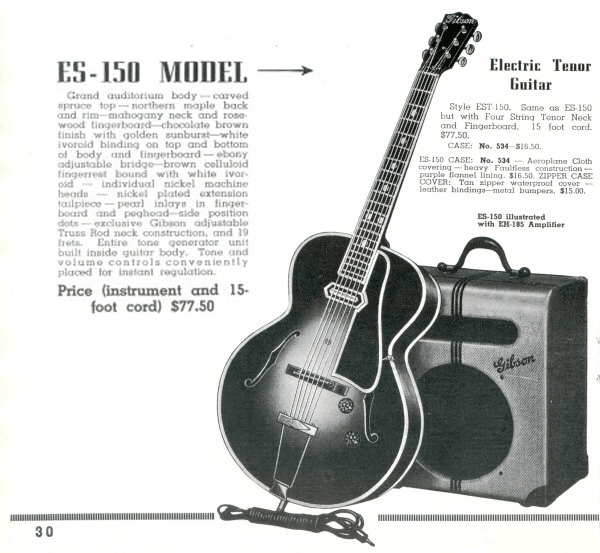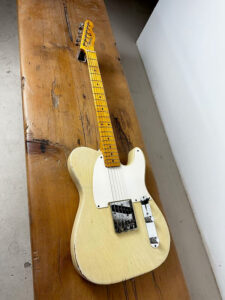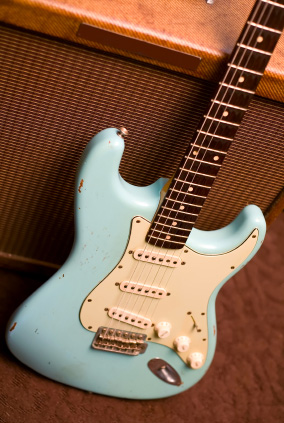 The blues before the 1940’s was mostly played on acoustic instruments. I suppose the same thing could be said of jazz music as well.
The blues before the 1940’s was mostly played on acoustic instruments. I suppose the same thing could be said of jazz music as well.
But amplification had a much bigger affect on the blues.
Why?
Well blues was mostly played in juke joints, bars and clubs, where people tended to make a lot of noise and get rowdy. Also in that atmosphere, dancing was enjoyed if not encouraged. Loud dance blues music was welcome and fit in well with the scene in these venues. The acousitc guitar could not “cut it” in these situations
So with amplification, now the guitar, in jazz, blues, and even country music, could become a real lead instrument. It was a major paradigm shift for the guitar in all kinds of music. It’s role in the music could change from just being a background, rhythm instrument to being a major player and influencer of “the sound.” You could argue that all music would forever be changed.
And besides volume, the amplification of guitars made for a brand new sound. Guitars, when turned up loud, had an entirely different tone than when played acoustically. In fact, amplifiers and louder volumes required an entirely new instrument… the solid body guitar.
But first…
The First Electrics
The first electric guitars were actually acoustic guitars with pickups that fitted into the sound holes of the guitar. You then ran these pickups into a PA system. These were acceptable but still had problems… like feedback when turned up too loud..
The first usable electrics came from Gibson in 1936, and were originally played by jazz players like Charlie Christian and George Barnes.
The first Gibson electrified model was the ES-150. The “150” was suppose to indicate the selling price… $150, which also included amplifier and case. But in the ad below the price is $77.50. It was sold via Montgomery Ward and Spiegel catalogs. Gibson stopped making the original model in 1940. But a new version is still being made.

Gibson ES-150 and Amp
The New Solid-Body Electric Guitars

Fender Esquire
With most electric guitars before 1949 being hollow, like an acoustic guitar, they tended to resonate in a not always pleasing way. This was called feedback and actually prohibited the guitar from getting as loud as possible. This was the type of electric guitar being played throughout the 1940’s.
So the evolution of the electric guitar went from adding “pickups” to acoustic guitars, to creating hollow-body guitars designed specifically to be electric, to creating guitars that were not hollow, but were a solid slab of wood. These “solid body” guitars didn’t feedback and could be turned up much louder. Gibson had prototypes of solid body guitars as early as 1945 but it was Leo Fender who introduced the first commercially available solid body guitar in 1949 and called it the Esquire. The name quickly changed to The Broadcaster… but due to patent problems that named had to be changed to the Telecaster.
The New Sound
These solid body guitars also had an edgier, more biting tone which also lent itself to blues music and really a whole new style of blues and later rock and roll.
The inventors of these solid body instruments, like Leo Fender and Les Paul, would go on to great fame and financial success, because of their innovations. But the resulting effect on the music was just as important. Who can imagine music of the 1960’s without that loud, distorted guitar sound.

Early Fender Stratocaster and Fender Amp
The first guitar amplifiers were heard in the 1930’s, when the first vocal electronic microphones were also coming into existence. Early pioneers were Western Swing musicians, who also played for some rowdy audiences and needed more volume. The first blues recordings featuring the electric guitar were made in 1938, when George Barnes appeared on a Big Bill Broonzy session and Casey Bill Weldon (the “Hawaiian Guitar Wizard”) played an amplified steel guitar on two songs.
The first blues artists to amplify their guitars were T-Bone Walker in California, Memphis Minnie, Broonzy, and Tampa Red in Chicago, and Robert Nighthawk, Robert Lockwood, Jr., Elmore James, Joe Willie Wilkins, and Houston Stackhouse in Mississippi and Arkansas.
But it was clearly T-Bone Walker who would spread the electric guitar and have the most impact on the music itself. His sound and technique are yet to be duplicated.
Guitar amplification became the standard after World War II with the arrival of widespread availability of electricity to rural areas such as the Mississippi Delta and mass-produced electronic instruments. Just about all music, but especially blues and rock and roll would forever be changed.
Don’t Forget About The Bass
The bass instrument in a band suffered much the same volume problem. And with guitars being amplified, now the bass was not loud enough. Early bassists tried a microphone on their acoustic basses. But this often had a similar feedback problem.
When the electric, solid body bass was introduced in 1951 by Fender, and with appropriate amplifiers available as well, now the bass could compete with the rest of the instruments in the band.
So the electric bass, and the amplifiers (usually Fender’s) for them, also had a big part in the evolution of blues music. This was particularly true in Chicago in the late 40’s and early 1950’s, where Muddy Waters was developing his band and his sound. Electric blues was here to stay.
Love That Distorted Tone
The sound of an electric solid body guitar and an amplifier turned up loud, brought an entirely new sound to the world. At first this “distortion” was frowned on by record producers and sound engineers. But soon producers like Sam Phillips at Sun Records in Memphis took to the sound and actually made it part of the music they were creating.
Actually many of Sam’s early blues and rock recordings featured Ike Turner and his band as backup, and Ike was one of the first to go for this distorted sound with his band. What many say was the first rock and roll recording, Rocket 88, featured Ike’s guitarist’s distorted guitar sound. The song was credited to Jackie Brenston and His Delta Cats, which was just Ike’s band with a different name. His band was called Kings of Rhythm and they did a lot of the back up for Sam’s recording’s at Sun Studios.
Here you can hear the original song. Notice the distorted guitar line.
Actually this type of music was popular as “jump blues” throughout the late 40’s. It’s just that the distorted guitar had not been added yet. There were mostly horns on jump blues records. But that all changed when the guitar got amplified.
Of course this distortion sound has evolved and become an integral part of not only the blues but most of rock and roll as well. After the 50’s, and especially after English guitarists “adopted” the blues for their own, distorted guitar was as common on blues records as “low down women” in the lyrics.
But no question, once the guitar got amplified things changed, and blues would never be the same.


